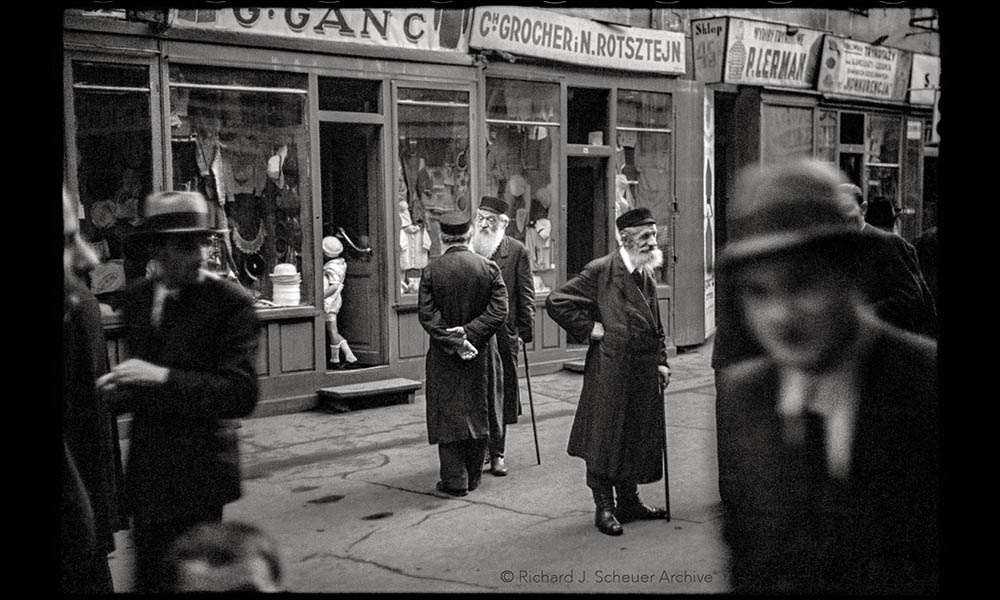For eight weeks during the summer of 1934, a 17-year-old high school student from New York by the name of Richard J. Scheuer (known to family and friends as Dick) and his father, Simon, traveled through Europe. Dick’s passport picture (below) shows a camera strap positioned diagonally across his chest. It held a 35mm rangefinder camera, likely a Contax or Leica, which he would use to document the trip.
As photography editor of his high school yearbook, young Scheuer was by all accounts a knowledgeable photographer and had likely attended art and photography exhibitions in Manhattan, where he might have encountered the work of Alfred Steiglitz and perhaps even French photographer Henri Cartier-Bresson, who pioneered the genre of street photography.
Going through 13 rolls of film (some 370 frames) as he traveled from France and Spain to Italy, Yugoslavia, Hungary, Poland and the USSR, Scheuer took a remarkable series of photographs. The 35mm camera he carried, compact and comparatively light, had been out for about ten years and necessitated no tripod or cumbersome plates. It did, however, require some experience and know-how to operate.

Richard J. Scheuer Passport 1934
The camera’s portability and unobtrusive appearance allowed Scheuer to record the casual, spontaneous images he sought. His keen eye for composition, precocious perception of light conditions, canny sense of timing and particular talent for engaging strangers helped him create a unique and intriguing record of the people and places he encountered. From a watermelon seller in the Jewish quarter of Warsaw to a gathering of men outside a mosque in Sarajevo, from a butcher in the Basque region of France to a performance of a Sholem Aleichem play at the Moscow State Yiddish Theater, Scheuer captured the immediacy of everyday life in Western and Central Europe just five years before the start of World War II.

Men in front of clothing store, Warsaw.
Scheuer’s portraits of shopkeepers and street vendors—ordinary people going about their daily business—exemplify his ability to empathize and connect with people. In his series of photographs from Warsaw’s Jewish quarter, the very space that six years later would become the infamous Warsaw Ghetto, members of the community—a shoemaker, a paint store proprietor, passersby—appear generally relaxed and free, unaware of the horrors to come. It was, in fact, on August 19 of that summer that Adolf Hitler, as German Chancellor, abolished the office of the President and declared himself Führer.

Shoemaker and customers, Warsaw.
The great advantage of a rangefinder camera is that it allows one to see what is outside of the actual frame or, in other words, what is about to come into the frame. Scheuer was thus able to compose his images with great precision. His compelling framing, together with his ability to engage his subjects and capture fleeting gestures and expressions, anticipate the aesthetic of 35mm street photography of the 1950s and 1960s and the work of such luminaries as Robert Frank and Garry Winogrand.

Man in front of paint store, Warsaw.
When Scheuer returned from Europe, he had the highly flammable nitrate negatives developed and contact strips printed, but he never enlarged or printed any of the images. Instead, he placed the negatives and paper contact strips in a cardboard box and stored them away. He graduated from the Ethical Culture Fieldston School the following spring and went on to undergraduate study at Harvard, service as an officer in the Army Signal Corps during World War II, a career as a real estate executive, and a variety of philanthropic work.

Sholem Aleichem’s The Jackpot, Moscow State Yiddish Theater.
He served as board chair at the Jewish Museum, New York and at the Hebrew Union College-Jewish Institute of Religion, where he led the development of HUC’s Jerusalem campus in partnership with architect Moshe Safdie. Throughout his life, he continued photographing as an amateur, with most of his work focused on family.
The box of negatives and contact strips sat untouched on a closet shelf for decades. It was only after Scheuer’s death in 2008 at age 91 that his son Dan retrieved it from its perch and decided to see exactly what it held. After taking a close look at the negatives and contact strips, he realized that the family had an untapped treasure on its hands and a legacy to preserve. In 2018, he decided to digitize the negatives and repair any damage. To that end, he and his brother Jonathan employed the expertise of their friend Charles Seton, a specialist in digital photo restoration.
Photo Gallery:

Man outside women’s apparel store, Warsaw.

Street scene, Warsaw.

Man with fez, Sarajevo, Yugoslavia.

Butcher, Saint-Jean-de-Luz, France.

Ringmaster character, Moscow Children’s Theater.

Gazi Husrev-beg mosque, Sarajevo, Yugoslavia.

Girls in hats, France.

Cheesemonger, Saint-Jean-de-Luz, France.

Man in train station, Warsaw.

Watermelon seller, Warsaw.

Széchenyi baths, Budapest.
 Fabric shop, Sarajevo, Yugoslavia.
Fabric shop, Sarajevo, Yugoslavia.
Now, finally, 88 years after young Dick Scheuer returned from his European expedition, 39 of his photographs from 1934 will be on public display for the first time at the Dr. Bernard Heller Museum at the Hebrew Union College-Jewish Institute of Religion, 1 West 4th Street, New York City. The show, “Street Visions: Europe, 1934 – Photographs by Richard J. Scheuer” will be on view August 22 to December 15 in the museum’s Backman Gallery. For information about hours, tours, a webinar and more, go to: http://huc.edu/streetvisions.



Thank you for sharing these very special photographs from Richard Scheuer. It is unfortunate that the reason for their long term storage is unknown. Perhaps it adds to the mysteriousness of the photos. Thank God they are now available for the public to admire and remember better times.
Lovely, haunting
So amazing to see these, as they offer yet another glimpse into a world that met with such horrific devastation. These sparks will help us all to remember and never forget.